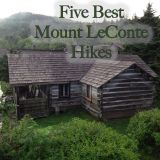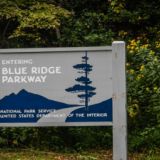Winter Hiking in the Smoky Mountains | What You Need To Know and Where To Go!
The best thing about the Smokies is that every season of the year offers its own joys! Get out today, hike one of the park’s beautiful trails and get a taste of winter’s glory in East Tennessee or Western North Carolina. From frozen waterfalls to forests laced with light snow, everyone from beginners to experienced hikers will find winter hiking in the Smoky Mountains delightful! What’s more, local outfitters can get you the base gear you need to enjoy a day in the heart of Great Smoky Mountain National Park. A few of them share with us what you need to know and where to go for winter hiking fun in the Smoky Mountains!
Michael Shepperd of GSM Outfitters in Wears Valley enjoys hiking in winter for a number of reasons. “Oftentimes I like to hike the most popular trails in winter, mid-week, to have a quiet, peaceful hike that would otherwise be very crowded and congested. I hiked on a Wednesday in the beginning of December to Abrams Falls (in Cades Cove). Besides myself and my wife, we saw no one. I took long-shot photos of the falls without one person being in the frame. Hikes like Abrams or Ramsey Cascades are great to go to in the winter if you enjoy owning the falls. For photography, oftentimes these experiences are priceless!”
Shepperd, whose store offers hikers just about everything they need to stay comfortable on a chilly day, including base layers of clothing, great winter coats, hats, gloves, boots, Microspikes (to keep feet from slipping on icy trails), trekking poles and more, has plenty of other reasons for hitting the trails of the Great Smoky Mountains after the weather turns cold.
“Hikes like Bote Mountain, Rich Mountain, or any ridgeline hike are great in the winter. With dramatically reduced foliage, the views on these hikes are even more spectacular only during late fall, winter and early spring. Winter is also a great time to do waterfall hikes. Water tables are up, normally thirsty plants are not taxing ground water, and with most of the leaves gone there are vantages that are not available in the summer. Hikes like Mt. LeConte and Charlie’s Bunion will oftentimes render views of frosted peaks, dense clouds and land contours that are normally hidden under blankets of green,” Shepperd says. For more info, give GSM Outfitters a call at 865-366-2608.
John Northrup of the Nantahala Outdoor Center in Gatlinburg, says that if the area has recently been hit with decent snowfall or ice affecting roads, visitors still have options. “Odds are if the roads are icy or snow-covered, access to the heart of the park via US 441 will be prohibited until they are deemed safe for vehicular traffic. If that’s the case, one will be limited to the roads and trails that can be reached around the park’s perimeter. Depending on how low the snowline is, parking at the entrances to Cherokee Orchard or Greenbrier can afford visitors opportunities to walk the gravel roads or trails with comfort and ease. It doesn’t take long to achieve that sense of solitude in the woods and still be so close to Gatlinburg,” he says. For the more experienced hiker, there are even more exciting options under these conditions. “Take the drive east from Gatlinburg to I-40 and enter the park at Big Creek (exit 451). Park by the ranger station and walk the gravel road toward the campground or ascend any of the trails emanating from the ranger station that ascend Mounts Cammerer or Sterling. The views of snow-covered mountains on a clear day from either summit’s observation tower are breathtaking,” Northrup advises. For more info, call NOC in Gatlinburg at 865-277-8209.
Steve Ellis, owner and chief guide at Hike the Smokys, a company offering guided hikes in the GSMNP, doesn’t let a little cold weather keep him from hitting the trails. In an email interview with HeySmokies, Ellis says “for me, the ‘best’ winter trails are the trails that foliage has restricted my ability to see historic structures, artifacts and views during the warm weather months. These trails are often in the lower altitudes, where you have easier access, and where communities once existed, such as Greenbrier, Old Settler’s Trail, Porter’s Creek, and the Old Sugarlands Trail, where the CCC Camp and the Old Stone House remain. I also like Baskins Creek (you’ll need to hike in from Cherokee Orchard Loop Road as the Roaring Fork Motor Nature Trail is closed from November 28 – March 24) and the Elkmont area, which is also a great place to find hidden and not-so-hidden ruins.”
Ellis, like Shepperd and Northrup, also enjoys grabbing some altitude on a cold day in the Smokies. “The higher altitudes are fun to explore, and see even greater views than in the warmer seasons, due to the incredibly clear visibility on clear days. I really enjoy a day hike on the Appalachian Trail heading east from Newfound Gap Park area to ‘The Jumpoff,’ located on the Boulevard Trail, and Charlie’s Bunion, further east on the Appalachian Trail,” he says.
Getting out and about in the Great Smoky Mountains National Park is a great way to enjoy nature in wintertime, but good planning is key. John Northrup says the Nantahala Outdoor Center’s well-stocked 18,000-square-foot flagship store in Gatlinburg has everything you need to make your hike a success. When asked what one item is the most crucial, he was clear that there are several “must-haves” in the gear department. “If there’s snow and ice, you’ll want traction devices like Microspikes to grip the slick surfaces and allow you to maintain a normal gait. Mid-cut hiking boots that are waterproof, worn with moisture-wicking socks, will keep your feet dry and comfortable. Add a gaiter that covers the top of your boot and the bottom of your pants to ensure a protective barrier from snow and debris,” Northrup says. He adds that hiking pants with side zippers that could be opened for ventilation are sometimes a good idea, depending on conditions. These would be worn with a base layer of leggings. “For the upper body, you’ll want a shirt with wicking properties next to the skin to keep you dry. If the elements call for it, sport a waterproof shell to go over the top. In between those two layers, that’s where you’ll add in your insulation, whether it’s down, synthetic or fleece. Carry a backpack to store these layers safely because you’ll need to shed/add them as your body temperature heats up as you move and cools down when you stop. To complete the ensemble, always bring a warm hat that can cover your ears, and gloves – preferably wind/waterproof – to protect your hands,” he says.
Ellis, who says he has lead hundreds of hikes in the Smokies over the last four years without a single injury, offers his clients years of outdoor experience. He has a wealth of excellent advice for HeySmokies readers who plan to hit the trails in winter. “For winter hiking weather, if it’s a day hike or a longer excursion, I recommend carrying a “day pack” with the following items: headlamp, small hand flashlight with extra batteries, cigarette lighter, waterproof matches, a campfire firestarter (fuel-soaked wood stick package), ace bandage (for ankle sprain), medical compress bandage, a few small bandaids, a few “mole-skin” patches to alleviate the growth and pain of a foot blister, antibiotic cream, surgical tape, a few gauze pads, a multi-tool knife, and 4-5 feet of of high-strength parachute cord for mending backpacks and strapping things together in case a backpack falls apart or you need to hang items over a fire to dry them out. Put in a few napkins to wipe your nose, toilet-paper and a wet wipe or two. Bring spare undershorts, hiking pants and socks. You’ll need something to carry water in (an hydration bag, plastic or collapsible container, such as the vinyl Platypus brand) and a high-quality water filter. Include a loud whistle, bear pepper spray, a fully-charged cell phone (that may work in certain areas of the park if you’re lucky). Wear your phone, pepper spray air horns and all batteries (including backups) in an inside pocket of your coat until you use them, close to your chest if possible, to utilize your body heat, to avoid having the battery performance diminished by the cold. Bring a translucent map compass with magnifier feature. A waterproof National Geographic park map is ESSENTIAL, with elevations and all official trails indicated (find someone to train you as to how to use it). Carry a few high-protein snacks, chemical hand warmer packets, two pairs of synthetic gloves,” Ellis says. While he admits that the list can be amended based on length of hike, he is determined never to be under-prepared! “Wear a belt, or carry one,” he says, adding that it should be one that “can double as a tourniquet with a latch that can be placed at any length, if you have some training as to how one is applied on a person with a major bleed wound.” Ellis, like Northrup, believes in layering and the use of waterproof footwear with removable spikes for icy conditions. It’s easy to see why he was a successful boy scout! To reach Hike The Smokys by phone, call 865-363-4663.
While GSM Outfitters and the Nantahala Outdoor Center are sure to offer anything the hiker’s heart desires or the body needs, the Smokies visitor who simply wants to take the family out for a quick walk in the woods on a short, well-travelled trail might find The Day Hiker in Gatlinburg a great stop before heading out! The shop, which is located on the Parkway in “The Village” shopping area, offers great value on basic items like rain ponchos and hiking sticks. They’ve got great t-shirts too, if you’re looking for a fun souvenir! The Day Hiker’s phone number is 865-430-0970.
No matter your skill or experience level, you can enjoy these mountains in winter. Leave your cares far behind and head out into the brisk, fresh, clean air of the Smokies!

Laurie Crater Battles – journalist, blogger, hiker, biker, mom, wife, animal and coffee lover who makes her home in Knoxville.












